LC11. Climate and Human Evolution

Chapter 11

Illustration courtesy of HOMINIDAE.COM

Paleoanthropologists—scientists who study the physical evolution of humans—call our species Homo sapiens. This means that we are part of a category of individuals who share common characteristics, the genus Homo, and that within that genus our group or species is called “sapiens.” Fossil evidence shows that there were once other species in the genus Homo, but now only one survives—us.
In reading this chapter you will find that Homo sapiens are members not only of the genus Homo but also of the family Hominidae and the order Primates. This is like saying you live in the city of Chicago, in the state of Illinois and the country called the United States of America. Genus, family, and order are progressively larger and more inclusive groups of organisms—just as city, state, and country are larger and more inclusive geographical terms.
The story of the evolution of our species actually begins with the first life forms on our planet. We have already told much of that story in previous chapters. In this chapter we start with the evolution of organisms that were the first members of the order Primates.
I. The Evolution of Early Primates
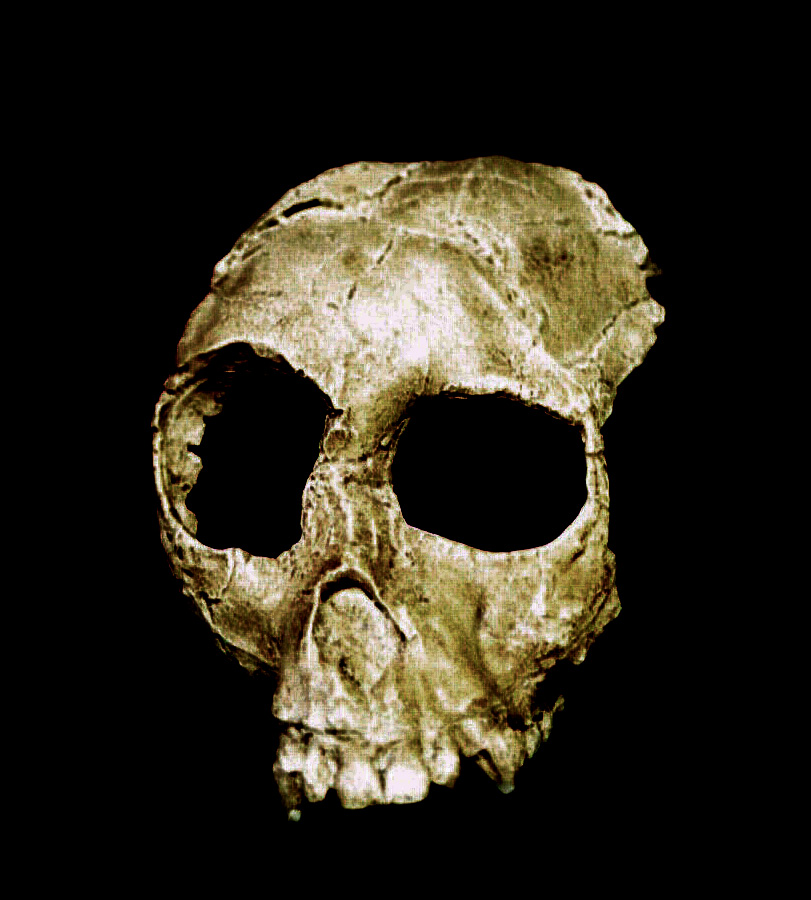
courtesy of Hominidae.com
Sixty-five million years ago, when the dinosaurs and many other species became extinct, a number of small mammals survived. Among the survivors were tiny tree-dwelling animals that had characteristics we may recognize in lemurs living today in the forests of Madagascar. From the rich fossil evidence, we know that these tiny creatures, who lived about 55 million years ago, had the distinguishing traits of primates. Primates have relatively large brains for their size, eyes that face forward, and hands and feet that can grasp, for example, tree branches and vines. Most primates also have flat fingernails rather than claws.
Primates are divided into higher and lower primates. The tiny Eocene creatures just described are classified as lower primates, along with today’s bushbabies and lemurs. Higher primates differ from lower primates in that they have larger, more complex brains, and eyes that are further developed and completely encased in bone. They can also show expression in their faces. Higher primates include monkeys, apes (such as chimpanzees and gorillas), and humans.
The earliest known fossils of a higher primate date to about 35 million years ago. Paleoanthropologists named this species Aegyptopithecus because the fossils were found in what is now Egypt. Aegyptopithecus was a monkey with a short tail and was about the size of a house cat. Although today the area where the fossils were found is desert-like, in ancient times, when these animals lived, the area was heavily forested and there were many rivers.
The next significant step in the evolution of higher primates is represented by Proconsul. Also found in Africa and dating to about 18 million years ago, this creature, which was somewhat larger than a monkey had a large brain for its size and no tail. Some paleoanthropologists believe that Proconsul was a distant relative of the modern great apes and humans.
II. The Influence of Climate
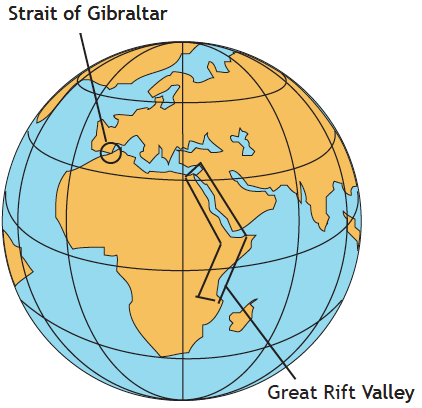
Over the past 40 million years, the landscape of eastern Africa has been shaped by repeated geological upheavals. The largest rupture of Earth’s crust, called the Great Rift Valley, is spread along 4,500 miles from Mozambique in southeastern Africa to southwestern Asia in the north. This enormous rift was initially caused by tectonic movements and earthquakes, which were then followed by many volcanic eruptions over millions of years. From all the tearing apart of the crust, layering of sediments, and changes in contours with each new disturbance, the land has an extraordinary variety of hills and plains, mountains, plateaus, and lakes. With such a varied landscape, the climate and vegetation are also varied, and the whole valley teems with life. It is not surprising then that many fossils have been found in this valley, including those of distant relatives of our species.
About 6 million years ago
Toward the end of the Miocene epoch, the cooling of Earth that had begun earlier intensified. Overall, the planet became colder and drier. This was the result of a number of circumstances. First, there was a shifting of the continents which caused changes in the pattern of ocean currents. (Ocean currents carry heat which then can affect regional climate.) As the climate became colder, great ice sheets grew in Antarctica and sea levels dropped worldwide. Finally, the northern edge of Africa and the tip of Europe came together, closing what is now the Strait of Gibraltar. As a result, over time, the Mediterranean Sea dried up. Without water evaporating from the sea, there was a significant reduction in rainfall. Consequently, forests were gradually replaced by grasslands.
III. The Evolution of Hominids
Scientists tend to agree that about 6 million years ago there must have been a common ancestor of apes and humans. While the species that gave rise to both lines of evolution has yet to be identified, it almost certainly lived in Africa.
In Africa, the Great Rift Valley had created many environments out of what had been essentially a huge, dense tropical forest. With further shrinking of the forest because of the arid (dry) condition, some of the ape species could not adapt and became extinct. Others were able to adapt and they survived. Their descendants are the modern gorillas, chimpanzees, and orangutans. Another survivor was an ape species that couldn’t compete for food and space in the constricted forest and moved onto the more open woodlands and growing grasslands—and stood in an upright position. This was a new kind of primate: the first hominid.
Walking in an upright position on two feet is called bipedal locomotion. It is the most prominent characteristic of hominids. We are hominids. The first hominids had a body that allowed this way of moving. To be able to stand upright and walk on two feet means that the pelvis (hip bones), muscles of the upper legs, and toes had to be shaped differently from those of other apes. In other words, the first bipeds had the body form that favored their survival in this new environment.
Did the first human ancestors walk upright before their environment changed from forest to grassland? Or, did they develop this ability after migrating to a grassland environment? There were no clues to help paleoanthropologists answer this question until new fossils were found. The July 14, 2001 issue of Science News, discusses some new discoveries by Yohannes Haile-Selassie, a graduate student at the University of California at Berkeley. Fossil fragments from the genus Ardipithecus include a toe bone which offers “subtle but clear evidence” that the individual walked upright on two legs. Although the current site of the investigation is now a desert, the environment was a lush forest when Ardipithecus lived—between 5.2 and 5.8 million years ago—before East Africa cooled and became grassland.
Paleoanthropologists have proposed several theories to explain why bipedal locomotion gave these early hominids an advantage that helped them survive the transition from trees to more open woodlands and grasslands. Some scientists have suggested that bipedalism is a more efficient way to walk on the ground. Others have pointed to the ability to see further, or to free the hands to carry food or twigs or rocks. Whatever the reason, it was bipedal locomotion that differentiated hominids from other primates. Increased brain size came later.
About 4 million years ago
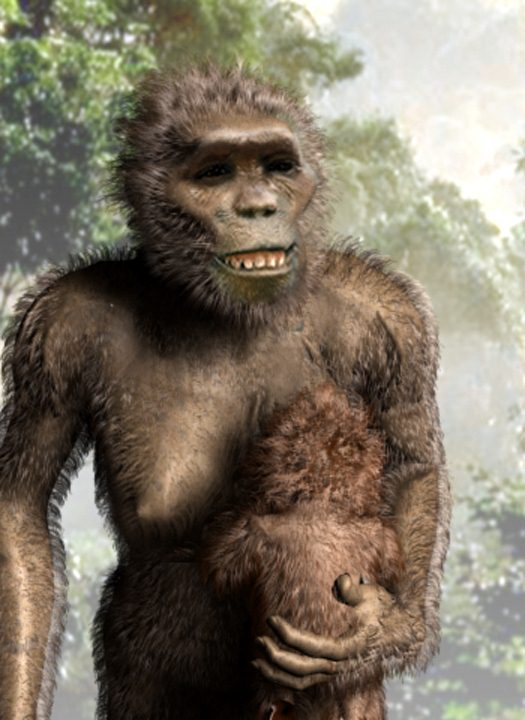
courtesy of Hominidae.com
In what is now Ethiopia and Kenya (part of the Great Rift Valley), and in South Africa, hominid fossils from about 4 million years ago include fragments of leg bones and the pelvic bone. The way these bones are configured shows that their owners walked upright on two feet, as we do. This interpretation was confirmed by an outstanding discovery. At a place called Laetoli in what is now Tanzania (also part of the Great Rift Valley), paleoanthropologist Mary Leakey and her colleagues found the fossilized footprints of at least two individuals walking side by side. Although the fossilized footprints were dated to 3.5 million years ago, the gait and shape of the feet left a trail remarkably like the trail that modern humans would make.
Who made the footprints? Although we don’t know anything about the particular individuals, we do know they were hominids that paleoanthropologists refer to as australopithecines or ape-men. Fragments of over 1,000 australopithecine individuals have been found, and paleoanthropologists have identified several species, which may represent adaptations to different environments.
In general, australopithecines had arms and feet that were more similar to humans than to apes, but their heads were more ape-like than human. They were also shorter in height than modern humans. Australopithecine adults were three to four feet tall. “Lucy,” perhaps the most famous of these fossils, was affectionately named by her discoverer, Donald Johanson. About half of Lucy’s skeleton was recovered, making it the most complete australopithecine skeleton ever found.
IV. Evolution of the Genus Homo
About 2.5 million years ago
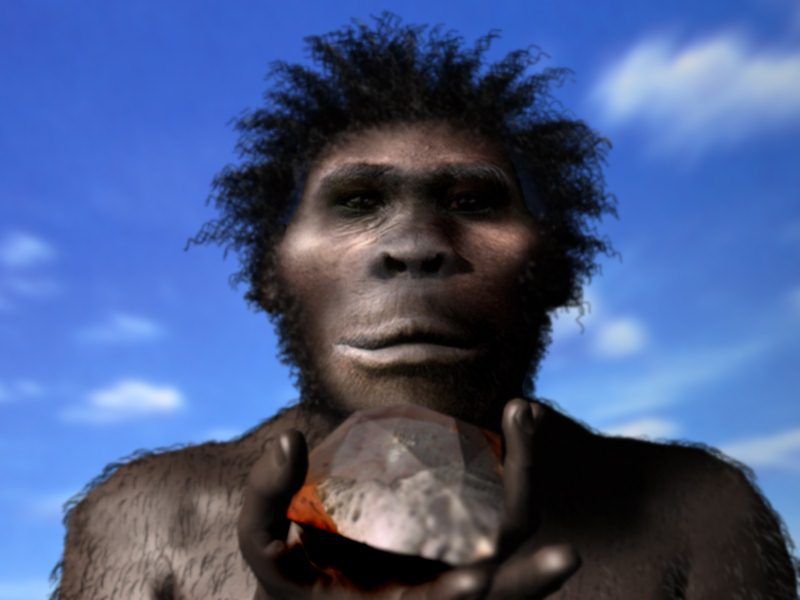
courtesy of Hominidae.com
After several short, warmer periods, Earth grew cold, possibly due to the formation of a land bridge between North and South America, which had previously been separated. The land bridge changed ocean circulation patterns and the distribution of heat. Large ice sheets formed in the Northern Hemisphere. This marked the beginning of a series of ice ages, which meant on average a cooler, drier climate worldwide. (Refer to the graph on page 71 to compare the climate change relative to previous periods in Earth history.)
Africa, however, being close to the equator, still had a primarily warm climate, although several mountains were snow-covered at the peak. Also, since altitude affects climate, the higher plateaus were cooler than lowlands.
On the expanding grasslands, where the climate was cool and dry, new hominid species evolved. Fossil evidence from about 2.5 million years ago shows that one hominid form had a little larger skull and bigger body than other hominid species. In addition, stones found near these fossils clearly had been shaped and sharpened to be tools. Recognizing that these tool users were a special group of hominids, paleoanthropologists classified them, our ancestors, in a separate genus (group of species)—Homo, which means “man” in Latin.
This maker of tools was given the name of Homo habilis or “handy man.” Members of this species had the intelligence to figure out how to shape a hard stone with another stone to produce a tool. Making tools implies that these early human ancestors were able to think ahead. They would have been able to imagine how the tools they were making would be used. They also had to apply knowledge about the stone’s cleavage, or splitting pattern, and they had to possess good hand-eye coordination. Important as these first efforts at toolmaking were, it should be noted that they were crude in comparison with later developments.
V. Evolution of Homo Erectus
About 1.9 million years ago
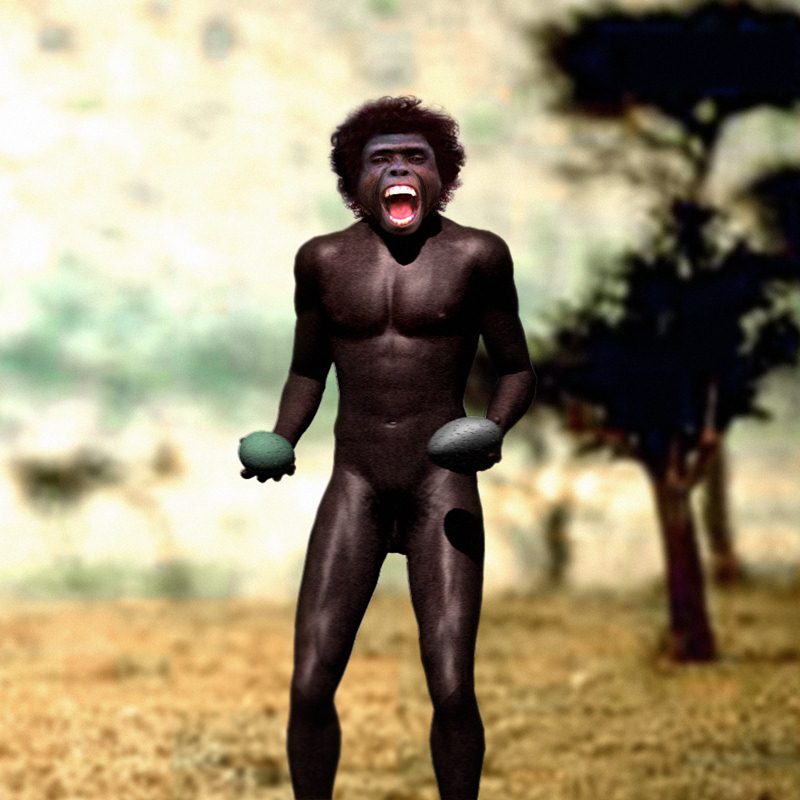
courtesy of Hominidae.com
Homo habilis survived and over time evolved, giving rise to Homo erectus about 1.8 to 1.9 million years ago. Both species probably lived side by side before Homo erectus prevailed.
By the Pleistocene epoch, starting about 1.6 million years ago, Earth had become even colder. There were long cold and dry periods alternating with relatively brief warm periods (interglacials). These shifting climate conditions and the available vegetation (food) would affect the life style and behavior of the inhabitants. To survive, new adaptations would be needed. Being intelligent and flexible, Homo erectus survived. The species flourished throughout Africa, and even spread to other continents. Their fossils have been discovered in Java, China, and Europe. Whatever the climatic condition, and that varied widely, Homo erectus had the capacity to thrive.
Skilled as Homo habilis was at fashioning tools, Homo erectus individuals were far more skillful. In every way, Homo erectus had greater capacities. Members of this species invented better stone tools and may have learned how to control fire, though not all paleoanthropologists agree on this point. In addition to scavenging for food, Homo erectus may have hunted animals, which is suggested from the many animal limb bones found at some sites. As for body size, Homo erectus was considerably larger than Homo habilis. Fossil evidence also shows that the Homo erectus skull was more like that of modern humans and that the enlarged brain was about two-thirds the size of ours. All the evidence, then, points to the conclusion that Homo erectus was more intelligent than Homo habilis and physically closer in appearance to modern humans.Fire!
No one knows when or how the earliest humans learned to control fire—to use it as protection from animals, and for warmth and cooking. However, there is evidence that by 300,000 to 400,000 years ago at least some groups of Homo erectus maintained hearth fires, probably by keeping alive glowing embers from lightning strikes, or from hearth fires handed down generation after generation. This idea is illustrated on page 108.
Until recently it was widely accepted that Homo erectus individuals were the first hominids with the intelligence to recognize the value of fire and to figure out how to keep it alive. However, in a December 1999 article in Current Anthropology, Harvard anthropology professor Richard Wrangham proposed that australopithecines as early as 1.9 million years ago may have developed the ability to control fire. In his theory, eating cooked foods may have made possible the physical and social changes that marked the emergence of Homo erectus from the earlier species.
VI. Neanderthals and Archaic Homo Sapiens
About 200,000 years ago
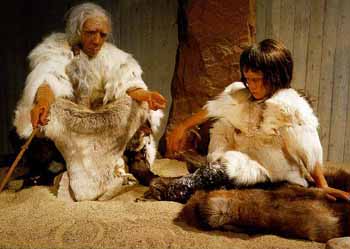
The fossil record shows clearly that by about 200,000 years ago Homo erectus had evolved into at least two species—archaic Homo sapiens (early modern humans) and Neanderthals.
Neanderthals
The Neanderthals were named for the Neander Valley in Germany where their fossils were first found. Since then, many Neanderthal fossils have been found, mainly in Europe—where it was colder than in Africa. Fossil skulls reveal that their brains were as large as ours, but shaped differently, as was the whole skull itself. With large bony brow ridges, huge jaws, broad nose, and small chin, their facial features and the shape of their skull were proportioned differently from ours. They were also shorter and more robust than modern humans; their skeletons show a sturdy, stocky build. A bulky body with short limbs and fingers suggests an adaptation to a cold climate.
Since bones and teeth retain signs of dietary deficiencies, scientists have much evidence of the Neanderthals’ physical condition. Studies indicate that Neanderthals suffered from poor nutrition. Perhaps they were unable to obtain enough food or the right kinds of food. Other studies of Neanderthal fossils show that they did not live as long as archaic Homo sapiens.
Fossil discoveries show that Neanderthals lived in much of Europe. Some paleoanthropologists believe that the Neanderthals’ sturdy bodies and large brains gave them an advantage in surviving cold conditions. However, remains of Neanderthals dating to less than 70,000 years ago were also found in warmer southwestern Asia and North Africa. Perhaps they were seeking a better climate and food source.
Along with the fossils, paleoanthropologists found stone tools which showed a higher level of craftsmanship than the tools made by Homo erectus. In addition, fossil remains indicate that the Neanderthals cared for the sick or injured and that they buried their dead.
No one knows for certain why they died out about 33,000 years ago. Some paleoanthropologists think that archaic Homo sapiens, ancestors of our own modern form, out-fought or out-competed the Neanderthals. Other scientists think that some Neanderthals interbred with Homo sapiens. Or perhaps the inadequate diet may have been a factor. Just what happened to them is still unknown.
Archaic Homo Sapiens
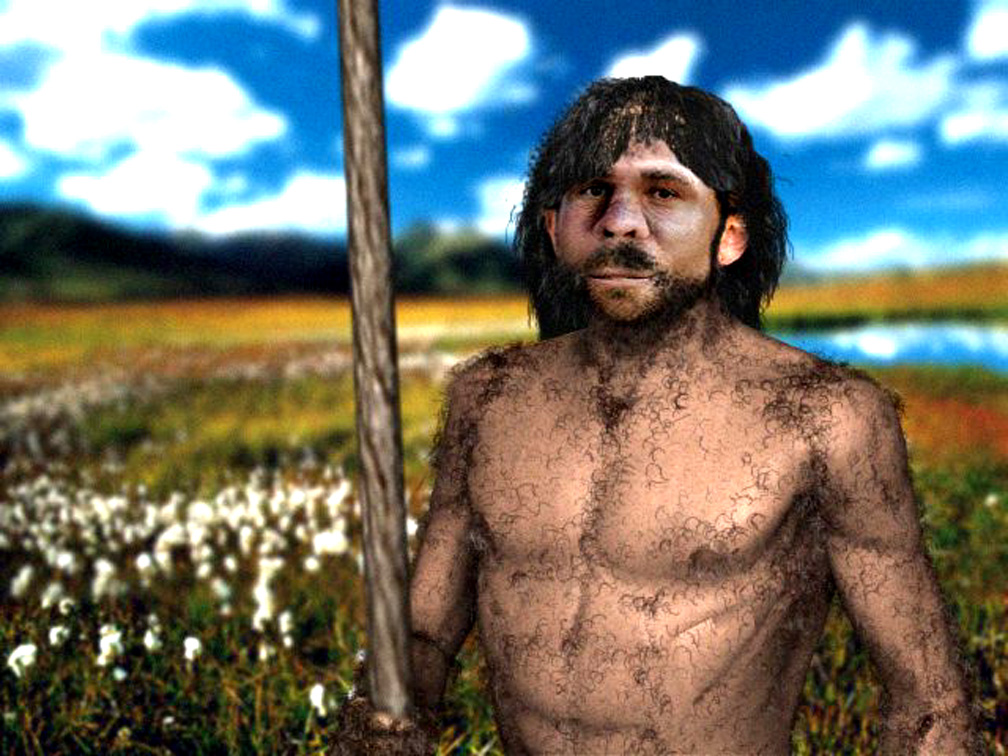
About 400,000 years ago, a new species was just beginning to replace Homo erectus. This emerging species was archaic Homo sapiens—the earliest members of our own species. Based on the fossil findings, by 200,000 years ago, archaic Homo sapiens were settled in much of Europe, southern and eastern Africa, India, and China. All the fossil skulls from these different regions are larger than skulls of earlier species, and the larger brain capacity is in the low end of the range for modern humans. The shape of their skulls, however, differed from ours, and some of the skulls show large brow ridges and thick bones. Other fossil skulls are somewhat more modern, so there was a mix of forms. Nevertheless, archaic Homo sapiens were more closely related to us than to Homo erectus. By 100,000 years ago, the fossil remains show what is termed “anatomically modern Homo sapiens,” that is, individuals with modern characteristics—like us.
The Evolutionary Bush
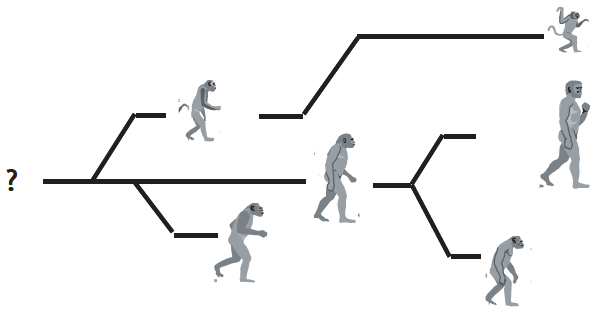
It is often said that the theory of evolution implies that people are “descended from apes,” and it is not uncommon to see an illustration of this idea like this drawing.
However, that simple explanation is not true. As this chapter illustrates, fossil evidence indicates that apes and humans had a common ancestor—a hominid that walked upright, and that was neither human nor ape. In the five to six million years since the first hominids roamed the forests and grasslands of Africa, there have been many different species. Most of those became extinct; but several species of apes and only one human species survive. The evolutionary tree of our extended family is more like a bush with many branches, than like a ladder or a pyramid with us at the top.
VII. Evolution of Homo Sapiens
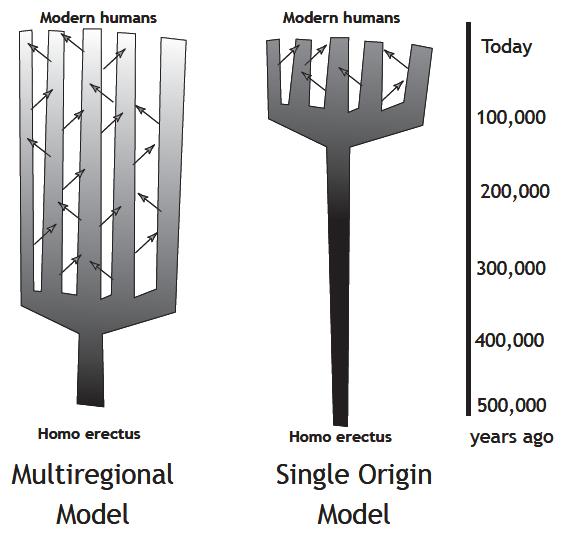
How did it happen that today all of Earth is populated with just one human species? Why did Homo sapiens prevail? In recent years, various theories have been proposed by scientists to account for the spread of our species, but there is no consensus. Basically, two models have been presented: (1) the single origin model, and (2) the multiregional model.
According to the multiregional model, modern Homo sapiens evolved from separate Homo erectus populations at about the same time in many different regions of Africa and Asia, starting around 500,000 years ago. Each population retained some regional distinguishing traits, but occasional contact between these populations kept the differences to a minimum. All developed into modern Homo sapiens.
According to the single origin model, modern Homo sapiens originated from a small population in southern Africa about 100,000 years ago. These more advanced humans replaced archaic Homo sapiens throughout Africa and then migrated into the middle East, southeast Asia, and Europe. Wherever they went, modern Homo sapiens replaced the earlier inhabitants who couldn’t compete and became extinct. Minor variations in human populations evolved in response to different environmental conditions, but occasional contact kept these variations to a minimum.
Between these two contrasting views, there is a middle ground. This theory holds that modern humans did arise in Africa and then spread into Asia and Europe. Instead of replacing the archaic populations, they settled with these local groups, thereby introducing modern characteristics.
VIII. Conclusion
Some people mistakenly believe that humans descended from apes. Fossil evidence shows that this is NOT true. In fact, both modern apes and humans descended from earlier life forms that have long ago become extinct.
In tracing the evolution of humans, we find that climate played a significant role. Many factors affect climate—height above sea level, distance from the equator, nearness to the ocean, and prevailing wind direction, among others. Climate in turn affected the condition of the soil and therefore the plants and animals that could survive in a particular region.
As the result of a changing environment, and therefore the plants and animals available for food, an ape species some 4 million years ago left the decreasing African forest and settled on the expanding open woodlands and grasslands. Since those bipedal apes took their first steps, various hominid species evolved. Some became extinct, but others further evolved. The only surviving species of the genus Homo is our own—Homo sapiens.
The origin of modern Homo sapiens is not fully understood. What is clear is that today there is one human species and that our species has adapted to all of Earth’s environments and climatic conditions.
In the next chapter, we will see how our ancestors not only adapted to changes in the environment but also transformed their lives through the development of agriculture and civilization.
In the field of paleoanthropology ideas about the early evolution of humans can change with each new discovery. In March 2001, a team headed by Meave Leakey (the daughter-in-law of Lewis and Mary Leakey) announced the discovery of a 3.5 million-year-old hominid skull that she believes represents a new genus which she has called Kenyanthropus platytops, or flat-faced man of Kenya. It may be many years before it is known if the skull represents a human ancestor or was simply one of evolution’s many dead ends.

